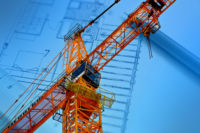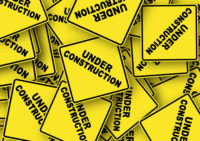January Construction Starts Recede 2% Nationwide
Residential building, at $134.5 billion (annual rate), dropped 8% in January. Multifamily housing fell 26%, retreating from the elevated volume reported in December. January’s amount for multifamily housing was still 5% above the average monthly pace for 2011 as a whole, a year in which the annual total for multifamily housing climbed 23%. The largest multifamily projects reported as January starts were the following—a $90-million apartment village in San Jose, Calif., a $78-million apartment building in Los Angeles and a $73-million, university-related apartment complex in Washington, D.C.
Single-family housing in January settled back 1%, as the result of this regional pattern—the Midwest, down 4%; the South Atlantic, down 3%; the Northeast, down 2%; the West, up 1%; and the South Central, up 2%. Single-family housing was able to show some gains during the latter months of 2011, with the average pace in last year’s second half up 7% relative to the weak first half, but Robert A. Murray, vice president of economic affairs for McGraw-Hill Construction, noted that “January’s essentially flat activity indicates that single-family housing has yet to move from what is still a very depressed level to even a modest recovery.”
Non-Building Construction
Non-building construction in January increased 3% to $127.9 billion (annual rate). Much of the upward lift came from electric utilities, which jumped 36% relative to a lackluster December. The electric utility category for 2011 as a whole surged 46%, reaching a new high in current dollar terms, although activity did slide back during the final two months of last year. Large electric-utility projects that boosted contracting in January were a $1.1-billion solar-energy facility in California, a $680-million transmission line project in California, and a $150-million wind farm in Indiana.
The public works categories in January showed varied behavior. Highway and bridge construction dropped 9%, continuing to see the reduced activity that was present for much of 2011, in which the annual amount dropped 5% after stimulus-supported gains in the previous two years. Water supply construction in January was down 5%, while river/harbor development fell a more substantial 26%.
January gains were posted by sewer construction, up 5%; and miscellaneous public works, up 18%. The miscellaneous public works category includes a diverse set of project types such as sitework and mass transit, and the January increase reflected these large projects—$406 million for site work at a mining development in Michigan, $234 million for a light rail project in California, and $157 million for work on a commuter rail corridor in Florida.
The 14% decline for total construction on an unadjusted basis in January 2012 relative to January 2011 was due to this performance by major sector—non-residential building, down 16%; residential building, up 17%; and non-building construction, down 30%.
Last year’s January amount for non-building construction featured several massive projects, including a $2.5-billion solar power facility in California and $2.1 billion for work on the LBJ Freeway in Dallas; the comparison to these projects contributed to the 30% year-over-year drop for nonbuilding construction.
By region, total construction for January 2012 compared to January 2011 revealed decreased activity in the South Central, down 32%; the Northeast, down 28%; and the West, down 11%; while gains were reported for the South Atlantic, up 1%; and the Midwest, up 16%.
The 3% decline for total construction on a 12-month moving total basis, meaning the 12 months ending January 2012 versus the 12 months ending January 2011, was due to this pattern by major sector—non-residential building, down 4%; residential building, up 4%; and non-building construction, down 8%.
By region, the 12 months ending January 2012 showed the following behavior for total construction compared to the previous 12 months—the Northeast and Midwest, each down 9%; the South Central, down 8%; the West, up 2%; and the South Atlantic, up 9%.



